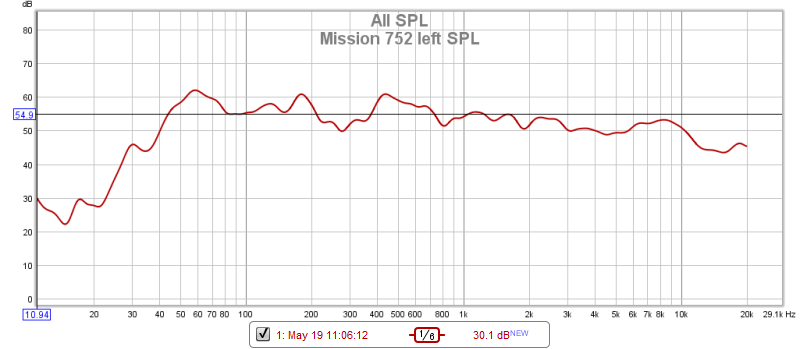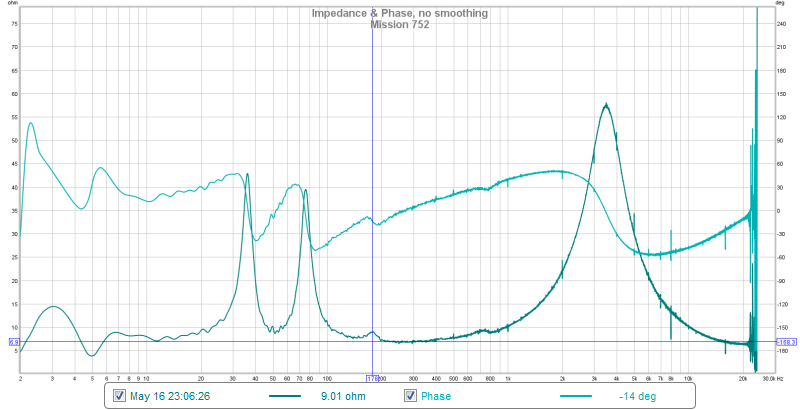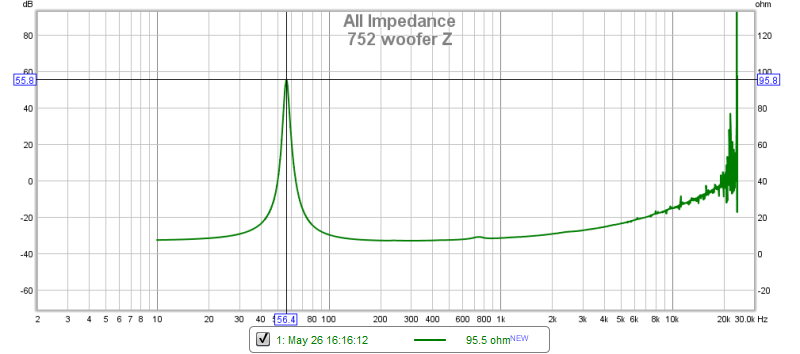You are using an out of date browser. It may not display this or other websites correctly.
You should upgrade or use an alternative browser.
You should upgrade or use an alternative browser.
Mission 752 measurements
- Thread starter davidsrsb
- Start date
davidsrsb
pfm Member
This is the in room measurement. Again ignore above 10kHz because of the microphone.
You see the typical reflex 50Hz bump and nothing beneath it, which leads to some one note bass.
The organ pipe boost around 170Hz can be seen. This Mission was designed for a "fast bass" which is what the ~170Hz boost does.
The bump around 7kHz made this speaker sound sibilant, why Mission swapped the tweeter in the later 752 Freedom model for a soft dome

You see the typical reflex 50Hz bump and nothing beneath it, which leads to some one note bass.
The organ pipe boost around 170Hz can be seen. This Mission was designed for a "fast bass" which is what the ~170Hz boost does.
The bump around 7kHz made this speaker sound sibilant, why Mission swapped the tweeter in the later 752 Freedom model for a soft dome

Are your Missions 752s the ones with the 3 reflex ports at the front?
It would be interesting to see the effect of using just 1 or 2 (rather than 3) of the ports. This should slightly reduce your peak at 50 - 80 Hz, also the level between 30 and 50Hz should be marginally increased.
The 2 room modes at 30Hz and 60Hz will still give you inceased level at these frequencies.
It would be interesting to see the effect of using just 1 or 2 (rather than 3) of the ports. This should slightly reduce your peak at 50 - 80 Hz, also the level between 30 and 50Hz should be marginally increased.
The 2 room modes at 30Hz and 60Hz will still give you inceased level at these frequencies.
davidsrsb
pfm Member
Yes that's the one. I think that the organ pipe resonances are more serious. There seems to be plenty of stuffing, so I am puzzled why this is so badAre your Missions 752s the ones with the 3 reflex ports at the front?
ToTo Man
the band not the dog
Maybe it's because you're using a 0dB to 90dB Y-axis scale but I'm not seeing that much of a HF boost, certainly not enough to be outright unpleasant on the ear, assuming the measurements were taken at tweeter height and on-axis from 1m distance. (The room should hopefully dampen some of the top-end in farfield measurements). Could you upload another FR graph with 20dB to 70dB as the Y-axis scale please?
The SPL of your measurements seems quite low. Do you live in an area with very low noise pollution? When I do REW measurements I calibrate levels for pink noise to average 75dB so that I'm a good bit above my external noise pollution which can get into the high 30dB's at times in the low frequencies.
PS - Are you certain that the 170Hz bump is actually the speaker's tuning and not its interaction with the room? I ask because whenever I take in-room measurements, particularly of stand-mounted speakers, I get a lot of dips and peaks below 400Hz due to floor/ceiling bounce.
The SPL of your measurements seems quite low. Do you live in an area with very low noise pollution? When I do REW measurements I calibrate levels for pink noise to average 75dB so that I'm a good bit above my external noise pollution which can get into the high 30dB's at times in the low frequencies.
PS - Are you certain that the 170Hz bump is actually the speaker's tuning and not its interaction with the room? I ask because whenever I take in-room measurements, particularly of stand-mounted speakers, I get a lot of dips and peaks below 400Hz due to floor/ceiling bounce.
I've been thinking about your 180Hz issue. It could possibly be a standing wave from the top to the bottom of the cabinet, but this is very unlikely if the cabinet is sensibly stuffed with damping material, also the frequency is a bit too low for this.
I would unbolt the woofer from the cabinet and measure the impedance again with the speaker on its back on the floor with the woofer raised about at least 20mm from its normal position. This would give you the norminal driver characteristics showing the natural frequency of the driver rather than the driver in its enclosure.
If the 170Hz bump in the impedance curve is still there is would suggest something in the driver is rattling.
I would unbolt the woofer from the cabinet and measure the impedance again with the speaker on its back on the floor with the woofer raised about at least 20mm from its normal position. This would give you the norminal driver characteristics showing the natural frequency of the driver rather than the driver in its enclosure.
If the 170Hz bump in the impedance curve is still there is would suggest something in the driver is rattling.
Craig B
Re:trophile
IME, Mission had a few too many 'house sounds', many of which seemed to be of a 'me too' flavour.
As this is the classic section, I'll admit to having really enjoyed the 710/720/730 and 700/717/727/770 series.
Not that there weren't some really good'uns afterward, but it wasn't just the model numbering that became confusing.
I blame μH for not sticking to amplifiers (or, was it F's fault for not caring enough to bother continuing changing crossover components every other week within a production run?).
As this is the classic section, I'll admit to having really enjoyed the 710/720/730 and 700/717/727/770 series.
Not that there weren't some really good'uns afterward, but it wasn't just the model numbering that became confusing.
I blame μH for not sticking to amplifiers (or, was it F's fault for not caring enough to bother continuing changing crossover components every other week within a production run?).
RustyB
Registered Ginga
Ah yes, the 752. Should have been a good speaker, with that high-tech Aerogel woofer and a pretty decent cabinet build.
Sadly, not a patch on its big brother, the 753.
Most obvious problem with mine was a fairly unpleasant and detached top end.
Now, there is actually nothing wrong with the tweeters used in the original 752 and 753, it's just the implementation.
The top end issue with the 752 was completely eradicated by upgrading the HF caps and wiring.
That still left a pleasant but ultimately less than enthralling speaker.
Craig's comments above made me chuckle. Various examples of the original 753 that have come my way have had no resistance, 0.5 ohms, or 1 ohms in series with the tweeter.
Unfortunately for the hapless 753 owners, around 3 ohms is the correct value.
Interestingly, judicious choice of amplification could disguise the imbalance and sound fine.
Bizarrely, partnering the unmodded 753's with a Cyrus 2, connected with Mission's own solid core speaker cable, produced an unlistenable screech.
You have to wonder what was going on at Mission Control.
Sadly, not a patch on its big brother, the 753.
Most obvious problem with mine was a fairly unpleasant and detached top end.
Now, there is actually nothing wrong with the tweeters used in the original 752 and 753, it's just the implementation.
The top end issue with the 752 was completely eradicated by upgrading the HF caps and wiring.
That still left a pleasant but ultimately less than enthralling speaker.
Craig's comments above made me chuckle. Various examples of the original 753 that have come my way have had no resistance, 0.5 ohms, or 1 ohms in series with the tweeter.
Unfortunately for the hapless 753 owners, around 3 ohms is the correct value.
Interestingly, judicious choice of amplification could disguise the imbalance and sound fine.
Bizarrely, partnering the unmodded 753's with a Cyrus 2, connected with Mission's own solid core speaker cable, produced an unlistenable screech.
You have to wonder what was going on at Mission Control.



